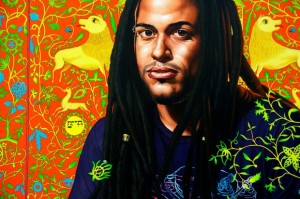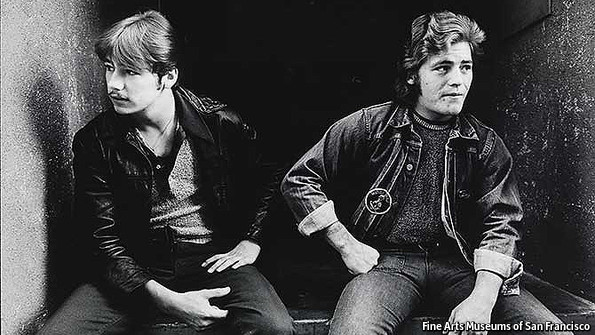 For the ECONOMIST: KEHINDE WILEY, an African-American artist, has gained attention for his vibrant, large-scale paintings that appear to mix urban hip-hop imagery with old-master portraiture. His subjects tend to be young black men in hoodies and jeans, who strike the confident poses of kings and aristocratic dandies against bright and ornate wallpaper-like backdrops. For his World Stage series, Mr Wiley has travelled the globe to paint portraits of black men from the streets of India, China, Brazil, Nigeria and Senegal. The most recent stop on this world tour was Israel, and his portraits of confident black Israeli Arabs and Jews are now on view at San Francisco’s Contemporary Jewish Museum until May 27th.
For the ECONOMIST: KEHINDE WILEY, an African-American artist, has gained attention for his vibrant, large-scale paintings that appear to mix urban hip-hop imagery with old-master portraiture. His subjects tend to be young black men in hoodies and jeans, who strike the confident poses of kings and aristocratic dandies against bright and ornate wallpaper-like backdrops. For his World Stage series, Mr Wiley has travelled the globe to paint portraits of black men from the streets of India, China, Brazil, Nigeria and Senegal. The most recent stop on this world tour was Israel, and his portraits of confident black Israeli Arabs and Jews are now on view at San Francisco’s Contemporary Jewish Museum until May 27th.
Dressed in a black Obama T-shirt, black jeans and black high-top trainers, Mr Wiley describes some of the unique challenges of his Israel paintings. “How do you have a conversation about Israel without discussing Palestine?” He asks. “And who am I to have the conversation I’m trying to have?” He adds that his role as an outsider makes his job both easier and harder. “I can allow myself to be destabilised and find new histories.”
As with his other World Stage paintings, these feature subjects Mr Wiley found through a method he calls “street casting”: during his wanders around a new city he meets and talks to people—some strangers, some acquaintances—and invites some to model in his studio. Many of the portraits in this show are of Ethiopian Jews whose families immigrated to Israel in the 1980s and ’90s during Israel-sponsored airlifts. Kalkidian Mashasda, an Ethiopian Jewish rapper from Tel Aviv, is in several portraits.
“Mostly I worked with friends of friends,” Mr Wiley says. “I wanted to work with males, ages 18 to 35, who in some way were dealing with or challenging the anxiety and narcissism of youth-entertainment culture.”
Mr Wiley’s subjects are set against elaborate backdrops based on the designs of religious objects, such as Torah ark curtains and Jewish wedding certificates. These patterns were chosen largely for their decorative quality, explains Karen Tsujimoto, the show’s curator. Trees, a central metaphor in Jewish culture, feature heavily, as do lions, snakes and birds. Each work, created with help from Mr Wiley’s studio assistants in Brooklyn and Beijing, is framed in wood and topped with two carved lions holding two tablets. On portraits of Jews these tablets display the Ten Commandments; for Arabs the text is a Hebrew translation of the phrase made famous by Rodney King, “Can’t we all just get along?”
There is something visually arresting about these large, bright, brash works. They are conspicuously hip and readily marketable; his designs now appear on skateboards and Puma trainer shoelaces, both of which are for sale in the gift shop. But his work can lack context. His young Israeli subjects don’t appear to have any connection to or relationship with the ancient artefacts they are paired with. What are we to learn about these men we’re gazing at? The answer is far from clear.
Critics have lauded Mr Wiley for his painstaking rendering of human skin in his portraiture, and his heroic depictions of black men. But some have described his work as misogynistic, campy and gaudy. Openly homosexual, Mr Wiley’s paintings are also often seen as homoerotic. “I always wanted to critique male identity and male beauty, and go against some of the codings we have to lay bare,” he says. “My work is a deconstruction of the language of painting, sexuality and class. It’s a lot more content than just hip hop.”
“The World Stage: Israel” is on view until May 27th at the Contemporary Jewish Museum in San Francisco. Image courtesy of the Contemporary Jewish Museum.




I have been exploring for a little for any high-quality articles or blog posts on this kind of area . Exploring in Yahoo I at last stumbled upon this website. Reading this info So i am happy to convey that I’ve an incredibly good uncanny feeling I discovered just what I needed. I most certainly will make certain to do not forget this website and give it a glance on a constant basis.
I’m impressed, I must say. Rarely do I come across a blog that’s both equally educative and interesting, and let mme ttell you, you have hit the
nail oon the head. The problem is somethuing which too few
men annd women are speaking intelligenbtly about.
I am verey happy I stumbled across this during my search for something relating too this.
Makes sense.. Awesomee information! Will check yokur otyer
posts….
Liked it…. Nice blog… Be back again.
[…] Articles: Colleen Ritzer kris jenner Jonathan Ferrell NFL Network Million Second Quiz […]
Vest Moncler Femme : doudoune moncler, pas cher moncler doudoune
Professionnel